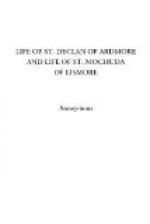The testimony of the “Lives” to the saints’ love and practice of prayer is borne out by the evidence of more trustworthy documents. Besides private prayers, the whole psalter seems to have been recited each day, in three parts of fifty psalms each. In addition, an immense number of Pater Nosters was prescribed. The office and prayers were generally pretty liberally interspersed with genuflexions or prostrations, of which a certain anchorite performed as many as seven hundred daily. Another penitential action which accompanied prayer was the ‘cros-figul.’ This was an extension of the arms in the shape of a cross; if anyone wants to know how difficult a practice this is let him try it for, say, fifteen minutes. Regarding recitation of the Divine Office it was of counsel, and probably of precept, that is should not be from memory merely, but that the psalms should all be read. For this a good reason was given by Maelruin, i.e. that the recitation might engage the eye as well as the tongue and thought. An Irish homily refers to the mortification of the saints and religious of the time as martyrdom, of which it distinguishes three kinds—red, white, and blue. Red martyrdom was death for the faith; white martyrdom was the discipline of fasting, labour and bodily austerities; while blue martyrdom was abnegation of the will and heartfelt sorrow for sin.
One of the puzzles of Irish hagiology is the great age attributed to certain saints—periods of two hundred, three hundred, and even four hundred years. Did the original compilers of the Life intend this? Whatever the full explanation be the writers of the Lives were clearly animated by a desire to make their saint cotemporary and, if possible, a disciple, of one or other of the great monastic founders, or at any rate to prove him a pupil of one of the great schools of Erin. There was special anxiety to connect the saint with Bangor or Clonard. To effect the connection in question it was sometimes necessary to carry the life backwards, at other times to carry it forwards, and occasionally to lengthen it both backwards and forwards. Dr. Chas. O’Connor gives a not very convincing explanation of the three-hundred-year “Lives,” scil.:—that the saint lived in three centuries—during the whole of one century and in the end and beginning respectively of the preceding and succeeding centuries. This explanation, even if satisfactory for the three-hundred-year Lives, would not help at all towards the Lives of four hundred years. A common explanation is that the scribe mistook numerals in the Ms. before him and wrote the wrong figures. There is no doubt that copying is a fruitful source of error as regards numerals. It is much more easy to make a mistake in a numeral than in a letter; the context will enable one to correct the letter, while it will give him no clue as regards a numeral. On the subject of the alleged longevity of Irish Saints Anscombe has recently been elaborating in ‘Eriu’




